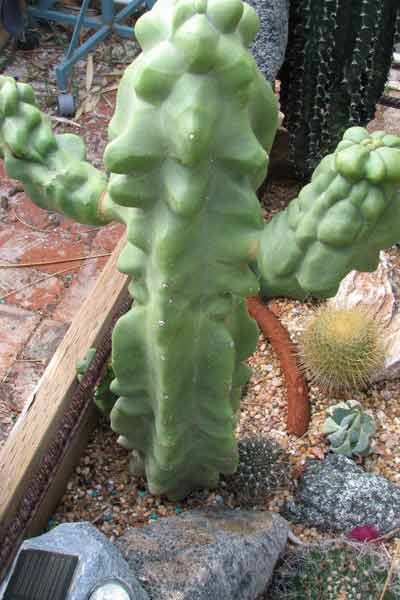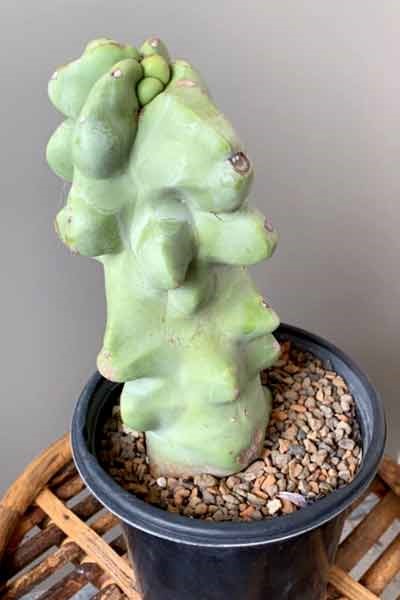Totem Pole Cactus: Pachycereus Schottii Monstrosus Care

Looking for another exotic cactus to add to your collection? We recommend the smooth-skinned totem pole cactus. Some may believe that there are more charming options to grow. But a true succulent aficionado can see the beauty of the marvelous totem pole cactus instantly.
If you are looking forward to growing your own totem pole, you can find all the information you need about this succulent below. First, we are going to talk about its characteristics and then cover totem pole cactus care, and its common diseases.
Totem Pole Cactus Information
Totem pole cactus botanical name is Pachycereus Schottii Monstrosus. Native to Mexico, it is a columnar cactus that can grow up to 10-12 feet (3-3.7m) in its habitat. It actually has 5 to 9 ribs and a short trunk, and the tall medium green-colored stems branch from it. These branches may fall due to strong winds, but they will root along their side.
On these stems, you can see the signature bumps of totem pole cactus that resemble faces; thus the name. Another famous characteristic is hair-like bristles on the tips of mature and tall stems. Also, this exotic specimen has no spines.
The totem pole cactus growth rate is slow in all verities. To reach the 12-feet height, the plant would need years.
Totem Pole Cactus Bloom and Flower
Blooms are a blessing, especially if you are growing a cactus. However, the totem pole cactus bloom may not be as gorgeous as you would expect it to be. The light pink pachycereus schottii monstrosus flowers bloom at night and close as the sun rises.
Totem pole cactus blooms are very rare. But when they appear in late spring, they are mostly in groups of 6 to 8 on each areole at a time. The flowers later produce red egg-shaped and edible fruits with pulp.

Totem Pole Cactus Care
Everyone would love to grow a fabulous and low-maintenance cactus that is not toxic and has no spines. Here are the care tips that you need to keep in mind when growing totem pole cactus varieties.
Light
Whether you are growing it indoors or outdoors, Pachycereus schottii monstrosus loves plenty of sunlight.
- When growing indoors, place the plant on the south-facing window or the sunniest spot in your house that you can find. Spots with partial sunlight or about 2 hours of sunlight per day will make your cactus show signs of distress. There is no place like warm and sunny spots for this specimen. So if there is not such a spot in your house, consider using grow lights.
- When growing outdoors, choose a spot with full sun. The totem pole cactus enjoys thriving in plenty of reflected heat, and in a colony with similar plants. Your plant will do just fine in such spots, as it tolerates high temperatures better than other types of succulents and cacti. So there is no need to look for a partially shady spot in your garden.
Temperature
When keeping the totem pole cactus indoor or outdoor, do not forget the right temperature. This plant handles heat very well, but it is not frost-hardy. So if you are growing this succulent outside, move it indoors when the temperature is below 24 ℉ (-4 ℃).
If it is not in a pot, cover its tips when the temperature is too low. To protect it against frost and freezing temperatures, cover your Pachycereus schottii monstrosus with a blanket or a frost cloth.
Tip: if you live in a climate with harsh winters, it is best to grow this plant in a suitable pot, so you can move it indoors in very low temperatures.
Soil
Most totem pole cactus varieties grow on rocky hillsides or soft sandy and gravelly soil in the wild. Therefore, similar to many other cacti, this specimen also grows best in rich, porous, and sandy soils with excellent drainage.
You can use common soils for cacti available in different stores, or make the soil yourself by combining equal parts of cactus potting mix, perlite, and coarse sand.
Water
Totem pole cactus is very drought resistant, but it still needs water. The amount that this succulent need varies depending on its size and the season.
If your Pachycereus schottii monstrosus is mature, water it every two to three weeks in the summer. But if it is younger, it needs more irrigation. These tips can help you more:
- If growing in the garden; Water the base of the plant thoroughly until it is soaked. Do not water again until the soil is dried out. Using this method, watering is not frequent (every 10 to 14 days in the summer is enough). Although, when the weather gets very hot or during intense heat waves, you should increase irrigation and slowdown in cold seasons.
- If growing in a pot; water thoroughly every two weeks in the summer, and then drain out the excess water to avoid root rot. Do not water your totem pole cactus again until the top 1 to 2 inches of the soil is dried out. In winters, watering every month should cover the plant’s water requirements.
- If recently transplanted; do not water the cactus right away. Let it settle for a week in the dry soil, so its roots can adapt to their new pot. After that, you can water your plant as mentioned above.
Totem Pole Cactus Diseases
There is no specific disease that hurts this plant. The most important thing that you should avoid is over-watering, as it causes root rot, a common problem among different succulents.
Potting and Repotting
If you want to grow your Pachycereus schottii outside, plant it in clay pots or other unglazed containers. The reason is that they let the excess water evaporate. Also, change the soil every two years so the plant can have all the nutrients that it needs.
For more encouragement, feed your totem pole cactus varieties every month with a good cacti fertilizer.

How to Propagate Totem Pole Cactus
Since totem pole cactus blooms are very rare and you need to be really patient to harvest its seeds, and most of its flowers and fruits are sterile, propagating pachycereus schottii monstrosus with cuttings is probably the best choice.
Growing cuttings doesn’t require the patient that growing seeds need. Here is what you need to do:
- Using a sharp and clean blade/knife, obtain cuttings at least 3 inches (7 to 8 cm) long with one or two good areolas.
- Lay the cuttings in a spot away from direct sunlight and allow them to dry. After a few days, you will notice a callus forming over the cut area. (Tip: it is not mandatory, but you can use horticultural sulfur powder in order to help seal the cut and prevent infection).
- Prepare a pot filled with suitable soil and when the callus has formed, push the cut end into the soil.
- As mentioned above, let the cutting settle for a week in the dry soil, so its roots can adapt to their new pot and then water it. Water once the top inch of the soil is dried out (test with your finger).
- Place the pot in a bright location (away from direct sunlight) and after 2 to 4 weeks, the cutting will form roots.
After this time, tug the plant gently. If you felt any resistance, it means that the roots have formed. Adjust watering as the plant matures and soon you’ll have a vibrant totem pole cactus in your home!
- In this post:
- Totem Pole Cactus Information
- Totem Pole Cactus Care
- How to Propagate Totem Pole Cactus



